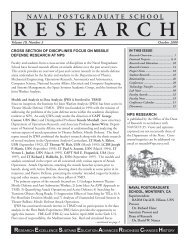Spectral Unmixing Applied to Desert Soils for the - Naval ...
Spectral Unmixing Applied to Desert Soils for the - Naval ...
Spectral Unmixing Applied to Desert Soils for the - Naval ...
You also want an ePaper? Increase the reach of your titles
YUMPU automatically turns print PDFs into web optimized ePapers that Google loves.
is <strong>the</strong> radiance above <strong>the</strong> atmosphere from <strong>the</strong> sun,<br />
is <strong>the</strong> <strong>to</strong>tal atmospheric transmittance,<br />
is reflectance from <strong>the</strong> surface material,<br />
is <strong>the</strong> angle of incidence of <strong>the</strong> sensor,<br />
is <strong>the</strong> path of <strong>the</strong> scattered radiance.<br />
Figure 1. The above figure shows how incident light interacts with surface materials<br />
via transmission, reflection, scattering and absorption (From Olsen, 2007).<br />
The accuracy of measuring land surface characteristics remotely is dependent on<br />
spectral, spatial, temporal, and radiometric resolution (Jensen, 1983). These different<br />
types of resolution are <strong>the</strong> dimension and number of wavelength intervals a sensor is<br />
sensitive <strong>to</strong>, <strong>the</strong> smallest angular or linear separation between imaged surface materials<br />
that can be determined by <strong>the</strong> sensor, how often <strong>the</strong> sensor is imaging <strong>the</strong> area, and how<br />
4
















